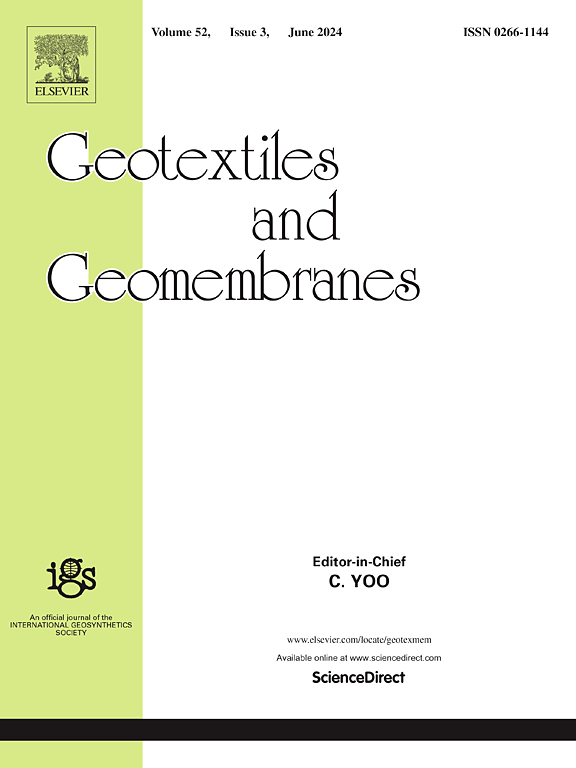Degradation of polyethylene geomembranes exposed to different mine tailings pore waters
IF 6.2
1区 工程技术
Q1 ENGINEERING, GEOLOGICAL
引用次数: 0
Abstract
The chemical durability of three 1.5 mm geomembranes (GMBs) – two made from high-density polyethylene (HDPE) and one from a blended polyolefin resin – was examined over 3 years in synthetic tailings pore water solutions. The immersion solutions included a pH 4.0 solution simulating pore water from oxidized copper-zinc mine tailings (PW-4), pH 7.0 (PW-7) and 8.0 (PW-8) solutions simulating arsenic-bearing pore waters from saturated gold mine tailings, and a pH 9.5 solution (PW-9.5) simulating pore water affected by cyanide complexes and/or chemicals from a cyanidation plant. Both HDPE GMBs reached nominal failure in stress-crack resistance at 85 °C, followed by reductions in melt index and, in some cases, tensile strength. The blended GMB showed no degradation. PW-7 was the most aggressive solution in terms of degradation of mechanical properties of the HDPEs, while PW-9.5 was the most aggressive for antioxidant depletion for all three GMBs. The relative performance of the three GMBs in different tailings pore waters could not be predicted from the GMBs’ initial properties or the solutions' chemistry. Overall, results highlight the importance of conducting immersion tests for applications involving complex chemical environments.
聚乙烯土工膜在不同尾矿孔隙水中的降解研究
三种1.5毫米土工膜(gmb)——两种由高密度聚乙烯(HDPE)制成,另一种由混合聚烯烃树脂制成——在合成尾矿孔隙水溶液中进行了为期3年的化学耐久性测试。浸没溶液包括pH为4.0的模拟氧化铜锌矿尾矿(PW-4)孔隙水的溶液,pH为7.0 (PW-7)和8.0 (PW-8)的模拟饱和金矿尾矿含砷孔隙水的溶液,以及pH为9.5的模拟氰化厂氰化物配合物和/或化学品影响孔隙水的溶液(PW-9.5)。在85℃时,两种HDPE gmb的抗应力开裂性能均达到了标称失效,随后熔体指数下降,在某些情况下,抗拉强度也有所下降。混合后的GMB无降解现象。就hdpe的机械性能降解而言,PW-7是最严重的,而PW-9.5对所有三种GMBs的抗氧化剂消耗最为严重。三种GMBs在不同尾砂孔隙水中的相对性能不能从其初始性质或溶液化学性质来预测。总的来说,结果强调了在涉及复杂化学环境的应用中进行浸入式测试的重要性。
本文章由计算机程序翻译,如有差异,请以英文原文为准。
求助全文
约1分钟内获得全文
求助全文
来源期刊

Geotextiles and Geomembranes
地学-地球科学综合
CiteScore
9.50
自引率
21.20%
发文量
111
审稿时长
59 days
期刊介绍:
The range of products and their applications has expanded rapidly over the last decade with geotextiles and geomembranes being specified world wide. This rapid growth is paralleled by a virtual explosion of technology. Current reference books and even manufacturers' sponsored publications tend to date very quickly and the need for a vehicle to bring together and discuss the growing body of technology now available has become evident.
Geotextiles and Geomembranes fills this need and provides a forum for the dissemination of information amongst research workers, designers, users and manufacturers. By providing a growing fund of information the journal increases general awareness, prompts further research and assists in the establishment of international codes and regulations.
 求助内容:
求助内容: 应助结果提醒方式:
应助结果提醒方式:


